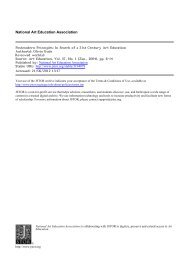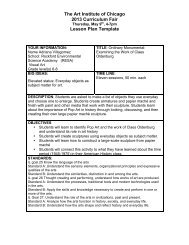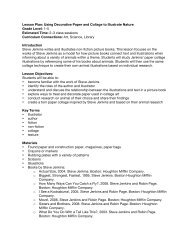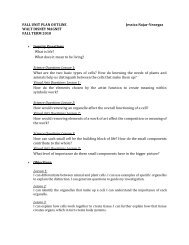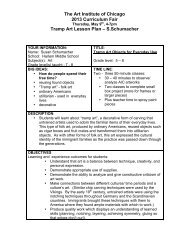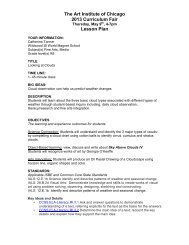Lesson 1 - LearningThroughMuseums
Lesson 1 - LearningThroughMuseums
Lesson 1 - LearningThroughMuseums
Create successful ePaper yourself
Turn your PDF publications into a flip-book with our unique Google optimized e-Paper software.
● Vocabulary<br />
blossom<br />
climate<br />
detail<br />
environment<br />
habitat<br />
image<br />
indigenous<br />
inference<br />
landscape<br />
observe<br />
petal<br />
realism/scientific-realism<br />
still life<br />
● Introduction<br />
1. Ask students to make two lists: “What I know about plants” and “What I know about<br />
paintings.” Tell them to keep those lists because they will add more information to them at<br />
the end of the lesson.<br />
● Part 1: Reading the Painting<br />
1. Have students take a close look at Magnolias on a Light Blue Velvet Cloth using the first two<br />
sections of the Art Reader handout.<br />
2. After students have completed their Art Reader, begin a discussion by asking students to<br />
describe what they see or recognize in the image.<br />
3. Ask them to count how many different blossoms are shown. Have them discuss what is similar<br />
and what is different among the blossoms in the painting. In what stage of development is each<br />
blossom?<br />
4. Ask the students what they think the flowers might smell and feel like.<br />
5. Explain to the students that the artist painted this to look exactly like the actual flower—as if he<br />
had used a magnifying glass to examine it carefully—and this is called scientific realism. Ask<br />
the students to tell why they think it’s called “scientific.”<br />
6. Explain that the plant grows in the southeastern United States. Ask how it is different from<br />
flowers that grow in the Chicago environment. Then “think” out loud to infer with students why<br />
the flower would be so big—what kind of climate it would need (warm and rainy). Point out<br />
that this is the climate of the southeastern United States where the magnolia grows. Explain that<br />
the longer the growing season the bigger a plant can get and that most large plants need much<br />
water.<br />
7. Ask students how they think the artist felt about the flowers he was painting. Explain that even<br />
the choice of the flower itself is a clue that the artist likes that type of flower. Point out that the<br />
artist probably wanted to help people see how special the magnolia is through his painting.<br />
8. Begin a pictorial word wall. Include terms the students use to describe the overall painting and<br />
the individual blossoms. Add more words as the lesson continues. Students should illustrate<br />
the terms.<br />
Art Institute of Chicago • 13



